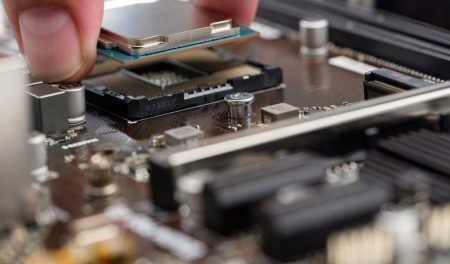As your computer ages and the downloaded files get heavier, your CPU gets loaded and heats up inevitably. Overheating can damage your computer, which is why you have a CPU fan to keep it cool.
But sometimes, the fan doesn’t function as well as it should. It could sometimes be too noisy, or it could run too slowly. In this case, you’ll need to change the fan speed. You can typically adjust this on BIOS, but there are three other methods you can use – which we’ll explore today!
1. Open the Control Panel on Windows
If you’re using a Windows laptop, you can easily adjust the fan speed on your control panel. Here’s how:
- Click on the Start menu in the bottom left corner of your screen and open the Control Panel.
- In the Control Panel, open the Power Options and select the Hardware and Sounds section. If you can’t find it quickly, you can type down ‘Power Options’ on the search tab.
- Once you’ve opened the Hardware and Sounds menu, click on Change Advanced Settings and you’ll get redirected to the Hardware settings.
- Scroll down and double-click on Process Power Management. Then, look for the System Cooling Policy option.
- When you do, you should find an active option. Click on it and pick between Plugged-in or On Battery. Either way, the fan speed will increase.

2. Install Fan-Control Software
One way is to install fan control software. As the name suggests, this software allows you to control your CPU fan with just a click. Additionally, you can monitor your computer’s performance and how your system reacts to certain activities.
Most of these software can be installed right from their official websites. Just don’t forget to check its compatibility with your system!
Here are some of the most popular fan control software you can install:
SpeedFan
SpeedFan is the preferred fan control software for computer enthusiasts. It’s user-friendly and easy to install. However, like any other software, it could be a bit of a challenge for beginners to play around with the configurations to get the results they want.
How to install SpeedFan:
- Download the software from the SpeedFan official site.
- Configure your fan speeds.
- Input your automated speeds.
HWMonitor
Another reputable fan control software is the HWMonitor. It monitors your computer’s voltages, temperatures, and fan speeds. The functions are similar to most softwares, however, the user interface is quite intimidating to beginners.
EasyTune 5
When it comes to versatility, EasyTune 5 is also a promising fan control software. Apart from being able to directly control your CPU fan, you also gain access to all sorts of convenient controls such as overclocking your CPU.
With direct control over your CPU fan, you can set the fan speed to match your CPU temperature. There’s just one thing to remember though – don’t set the threshold too high. Otherwise, your CPU won’t get enough airflow for its operations.
Notebook FanControl
Last but not least, we have the most user-friendly pick on this list – Notebook FanControl. This software is a lot easier to set up compared to other software and it’s pretty straightforward.
Notebook FanControl monitors your system’s temperature and turns on or speeds up the CPU fan when necessary. It’s best for those who don’t want the extra functions apart from fan control. You can just sit back, relax, and watch it do its job.
3. Set up an External Fan Controller
If you’re not as techy as you wish and want to just avoid the entire configuration process then you can opt to get an external fan controller instead. External fan controllers are much simpler to set up and sometimes work even better than fan control software.
There are a lot of different external fan controllers you can choose from and each of them differs in size, price, etc. The most important things to consider are its flexibility, its integrated channels and controls, and how much control it gives over the CPU fan.
Regardless, we highly recommend that you don’t go overboard with your purchase. After all, just because it’s expensive doesn’t mean it’s the best choice. Go for something with a good value for money like the Thermaltake Commander F6 or the Kingwin Fan Controller 4.

What Is the Best CPU Speed Fan for You
There is no magic number considered to be the ‘best speed’ to keep your system cool. It’s a case-to-case basis that’s often affected by external factors and user preferences. For example, having a warmer environment will require a higher RPM, a bit over 600. Whereas, you can settle for around 600 rpm or less for cooler rooms.
Another thing to consider is the sound. The higher the RPM, the louder the fan is, so if you don’t like the sound of a large fan then there’s no need to go as high as you can unless needed.
Hence, we recommend that you play around with the fan curve and see which suits you and your needs best.
Tips on How to Keep CPU Cool
Now that you know how to change your CPU’s fan speed, then it’s high time that we discuss different ways to keep your system cool. This way, you won’t have to struggle with issues and internal damages in the future.
Here are five quick and easy ways to keep your CPU temperature low:
• Clear Up Some Space
Believe it or not, having a cluttered setup messes up your CPU since it restricts airflow. So if you want to keep it cool, then you have to clear up the back and the sides of your computer.
• Clean Your CPU Fan Regularly
Dust accumulates on your fan the longer it runs. And when it gets too dirty, your fan can either get damaged or will not be able to cool your system at all. Hence, you should always set time to clean it once in a while.
• Keep Your Setup Away From Vents and Windows
Avoid setting up your computer in a warm area near vents or windows. This will only add up with the heat around it and will not do your system good.
• Keep the Case Closed
A common misconception is that your CPU gets cooler with the case off because of better airflow. However, this is counterproductive as this allows more dirt to penetrate your system. A big no-no!
• Upgrade Your CPU Fan
If you’ve done everything you could do but your system keeps on overheating, then maybe it’s time for a fan upgrade. There are a lot of better and larger CPU fans you can purchase, so you don’t have to worry too much!
Conclusion
To sum up, you can easily change your CPU fan speed without BIOS in three ways: using the control panel, installing a fan control software, or setting up an external fan controller.
When choosing between the three, it’s important to consider your needs and the most convenient way to do it. For instance, if you have a Windows computer, then the first method would be the quickest. If not, then you can go for either a fan control software or an external fan controller.














